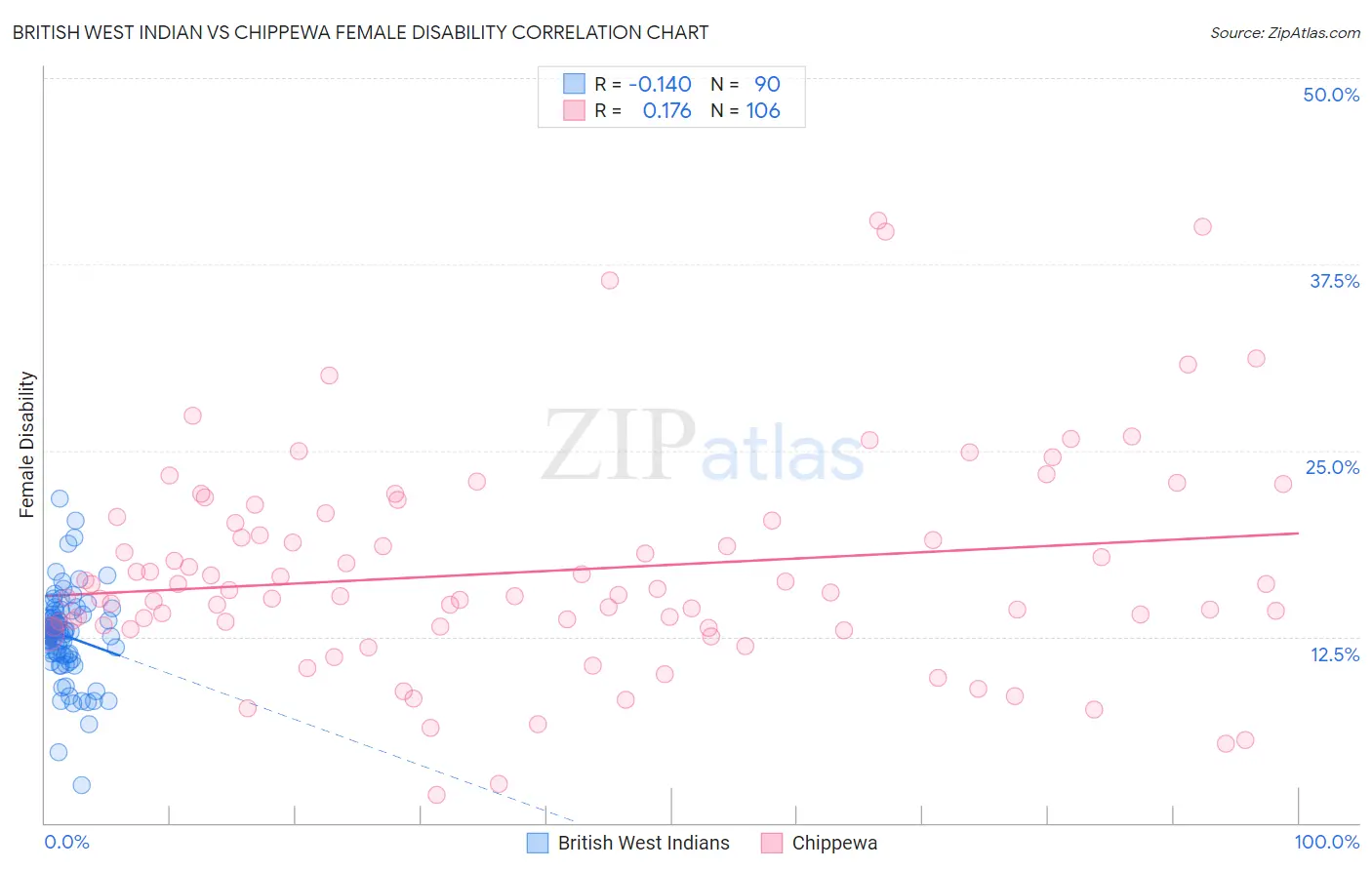British West Indian vs Chippewa Female Disability
COMPARE
British West Indian
Chippewa
Female Disability
Female Disability Comparison
British West Indians
Chippewa
12.7%
FEMALE DISABILITY
1.2/ 100
METRIC RATING
256th/ 347
METRIC RANK
14.0%
FEMALE DISABILITY
0.0/ 100
METRIC RATING
317th/ 347
METRIC RANK
British West Indian vs Chippewa Female Disability Correlation Chart
The statistical analysis conducted on geographies consisting of 152,669,776 people shows a poor negative correlation between the proportion of British West Indians and percentage of females with a disability in the United States with a correlation coefficient (R) of -0.140 and weighted average of 12.7%. Similarly, the statistical analysis conducted on geographies consisting of 215,042,988 people shows a poor positive correlation between the proportion of Chippewa and percentage of females with a disability in the United States with a correlation coefficient (R) of 0.176 and weighted average of 14.0%, a difference of 10.1%.

Female Disability Correlation Summary
| Measurement | British West Indian | Chippewa |
| Minimum | 2.5% | 1.9% |
| Maximum | 21.8% | 40.4% |
| Range | 19.2% | 38.5% |
| Mean | 12.6% | 16.9% |
| Median | 12.8% | 15.4% |
| Interquartile 25% (IQ1) | 11.3% | 13.1% |
| Interquartile 75% (IQ3) | 14.0% | 20.3% |
| Interquartile Range (IQR) | 2.7% | 7.2% |
| Standard Deviation (Sample) | 3.0% | 7.2% |
| Standard Deviation (Population) | 2.9% | 7.2% |
Similar Demographics by Female Disability
Demographics Similar to British West Indians by Female Disability
In terms of female disability, the demographic groups most similar to British West Indians are Liberian (12.7%, a difference of 0.030%), Aleut (12.7%, a difference of 0.030%), Immigrants from Germany (12.7%, a difference of 0.070%), Immigrants from Armenia (12.7%, a difference of 0.11%), and Subsaharan African (12.7%, a difference of 0.13%).
| Demographics | Rating | Rank | Female Disability |
| Immigrants | Congo | 1.8 /100 | #249 | Tragic 12.7% |
| Slovenes | 1.7 /100 | #250 | Tragic 12.7% |
| Crow | 1.6 /100 | #251 | Tragic 12.7% |
| Immigrants | Caribbean | 1.4 /100 | #252 | Tragic 12.7% |
| Jamaicans | 1.4 /100 | #253 | Tragic 12.7% |
| Hawaiians | 1.4 /100 | #254 | Tragic 12.7% |
| Immigrants | Germany | 1.3 /100 | #255 | Tragic 12.7% |
| British West Indians | 1.2 /100 | #256 | Tragic 12.7% |
| Liberians | 1.1 /100 | #257 | Tragic 12.7% |
| Aleuts | 1.1 /100 | #258 | Tragic 12.7% |
| Immigrants | Armenia | 1.0 /100 | #259 | Tragic 12.7% |
| Sub-Saharan Africans | 1.0 /100 | #260 | Tragic 12.7% |
| Bermudans | 1.0 /100 | #261 | Tragic 12.7% |
| Czechoslovakians | 0.9 /100 | #262 | Tragic 12.7% |
| Spaniards | 0.7 /100 | #263 | Tragic 12.8% |
Demographics Similar to Chippewa by Female Disability
In terms of female disability, the demographic groups most similar to Chippewa are Spanish American (14.0%, a difference of 0.11%), Paiute (14.0%, a difference of 0.11%), Iroquois (14.0%, a difference of 0.40%), Alaskan Athabascan (13.9%, a difference of 0.47%), and American (14.1%, a difference of 0.74%).
| Demographics | Rating | Rank | Female Disability |
| Apache | 0.0 /100 | #310 | Tragic 13.7% |
| Hopi | 0.0 /100 | #311 | Tragic 13.7% |
| Delaware | 0.0 /100 | #312 | Tragic 13.8% |
| Blackfeet | 0.0 /100 | #313 | Tragic 13.8% |
| Puget Sound Salish | 0.0 /100 | #314 | Tragic 13.8% |
| Alaskan Athabascans | 0.0 /100 | #315 | Tragic 13.9% |
| Spanish Americans | 0.0 /100 | #316 | Tragic 14.0% |
| Chippewa | 0.0 /100 | #317 | Tragic 14.0% |
| Paiute | 0.0 /100 | #318 | Tragic 14.0% |
| Iroquois | 0.0 /100 | #319 | Tragic 14.0% |
| Americans | 0.0 /100 | #320 | Tragic 14.1% |
| Potawatomi | 0.0 /100 | #321 | Tragic 14.1% |
| Pueblo | 0.0 /100 | #322 | Tragic 14.1% |
| Blacks/African Americans | 0.0 /100 | #323 | Tragic 14.1% |
| Natives/Alaskans | 0.0 /100 | #324 | Tragic 14.1% |